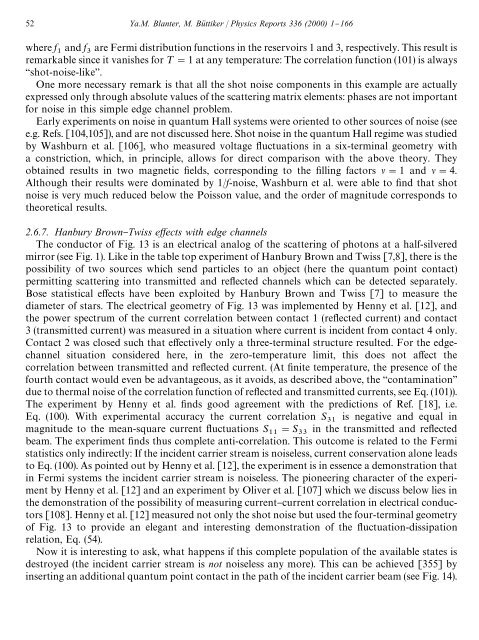shot noise in mesoscopic conductors - Low Temperature Laboratory
shot noise in mesoscopic conductors - Low Temperature Laboratory
shot noise in mesoscopic conductors - Low Temperature Laboratory
Create successful ePaper yourself
Turn your PDF publications into a flip-book with our unique Google optimized e-Paper software.
52 Ya.M. Blanter, M. Bu( ttiker / Physics Reports 336 (2000) 1}166<br />
where f and f are Fermi distribution functions <strong>in</strong> the reservoirs 1 and 3, respectively. This result is<br />
remarkable s<strong>in</strong>ce it vanishes for ¹"1 at any temperature: The correlation function (101) is always<br />
`<strong>shot</strong>-<strong>noise</strong>-likea.<br />
One more necessary remark is that all the <strong>shot</strong> <strong>noise</strong> components <strong>in</strong> this example are actually<br />
expressed only through absolute values of the scatter<strong>in</strong>g matrix elements: phases are not important<br />
for <strong>noise</strong> <strong>in</strong> this simple edge channel problem.<br />
Early experiments on <strong>noise</strong> <strong>in</strong> quantum Hall systems were oriented to other sources of <strong>noise</strong> (see<br />
e.g. Refs. [104,105]), and are not discussed here. Shot <strong>noise</strong> <strong>in</strong> the quantum Hall regime was studied<br />
by Washburn et al. [106], who measured voltage #uctuations <strong>in</strong> a six-term<strong>in</strong>al geometry with<br />
a constriction, which, <strong>in</strong> pr<strong>in</strong>ciple, allows for direct comparison with the above theory. They<br />
obta<strong>in</strong>ed results <strong>in</strong> two magnetic "elds, correspond<strong>in</strong>g to the "ll<strong>in</strong>g factors "1 and "4.<br />
Although their results were dom<strong>in</strong>ated by 1/f-<strong>noise</strong>, Washburn et al. were able to "nd that <strong>shot</strong><br />
<strong>noise</strong> is very much reduced below the Poisson value, and the order of magnitude corresponds to<br />
theoretical results.<br />
2.6.7. Hanbury Brown}Twiss ewects with edge channels<br />
The conductor of Fig. 13 is an electrical analog of the scatter<strong>in</strong>g of photons at a half-silvered<br />
mirror (see Fig. 1). Like <strong>in</strong> the table top experiment of Hanbury Brown and Twiss [7,8], there is the<br />
possibility of two sources which send particles to an object (here the quantum po<strong>in</strong>t contact)<br />
permitt<strong>in</strong>g scatter<strong>in</strong>g <strong>in</strong>to transmitted and re#ected channels which can be detected separately.<br />
Bose statistical e!ects have been exploited by Hanbury Brown and Twiss [7] to measure the<br />
diameter of stars. The electrical geometry of Fig. 13 was implemented by Henny et al. [12], and<br />
the power spectrum of the current correlation between contact 1 (re#ected current) and contact<br />
3 (transmitted current) was measured <strong>in</strong> a situation where current is <strong>in</strong>cident from contact 4 only.<br />
Contact 2 was closed such that e!ectively only a three-term<strong>in</strong>al structure resulted. For the edgechannel<br />
situation considered here, <strong>in</strong> the zero-temperature limit, this does not a!ect the<br />
correlation between transmitted and re#ected current. (At "nite temperature, the presence of the<br />
fourth contact would even be advantageous, as it avoids, as described above, the `contam<strong>in</strong>ationa<br />
due to thermal <strong>noise</strong> of the correlation function of re#ected and transmitted currents, see Eq. (101)).<br />
The experiment by Henny et al. "nds good agreement with the predictions of Ref. [18], i.e.<br />
Eq. (100). With experimental accuracy the current correlation S is negative and equal <strong>in</strong><br />
magnitude to the mean-square current #uctuations S "S <strong>in</strong> the transmitted and re#ected<br />
beam. The experiment "nds thus complete anti-correlation. This outcome is related to the Fermi<br />
statistics only <strong>in</strong>directly: If the <strong>in</strong>cident carrier stream is <strong>noise</strong>less, current conservation alone leads<br />
to Eq. (100). As po<strong>in</strong>ted out by Henny et al. [12], the experiment is <strong>in</strong> essence a demonstration that<br />
<strong>in</strong> Fermi systems the <strong>in</strong>cident carrier stream is <strong>noise</strong>less. The pioneer<strong>in</strong>g character of the experiment<br />
by Henny et al. [12] and an experiment by Oliver et al. [107] which we discuss below lies <strong>in</strong><br />
the demonstration of the possibility of measur<strong>in</strong>g current}current correlation <strong>in</strong> electrical <strong>conductors</strong><br />
[108]. Henny et al. [12] measured not only the <strong>shot</strong> <strong>noise</strong> but used the four-term<strong>in</strong>al geometry<br />
of Fig. 13 to provide an elegant and <strong>in</strong>terest<strong>in</strong>g demonstration of the #uctuation-dissipation<br />
relation, Eq. (54).<br />
Now it is <strong>in</strong>terest<strong>in</strong>g to ask, what happens if this complete population of the available states is<br />
destroyed (the <strong>in</strong>cident carrier stream is not <strong>noise</strong>less any more). This can be achieved [355] by<br />
<strong>in</strong>sert<strong>in</strong>g an additional quantum po<strong>in</strong>t contact <strong>in</strong> the path of the <strong>in</strong>cident carrier beam (see Fig. 14).
















